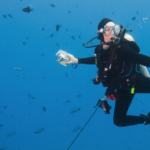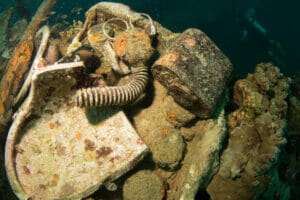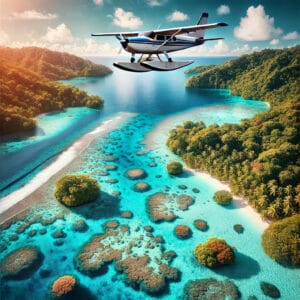Become a certified drift diver in Palau at the world’s best drift dive Blue Corner or the equally impressive German Channel. How could you ever top that?
Let’s face it there are hundreds of specialty and distinctive specialty courses available out there but only a few like diving with Nitrox require a full certification.
Some are frivolous, and the term underwater basket weaving has since the 60s been an idiom for a worthless college elective. Yes, there is an underwater basket weaving distinctive specialty. You can draw your conclusions.
One of the most useful specialty certifications to get is the drift diver specialty
There is nothing to stop you from going out and doing a drift dive as an Open Water Diver. However, drift diving or for that matter any type of diving in a current is an extra element of risk that can put you in harms way if you do not know or understand what you are up against.
To get the most out of your drift dives both in Palau and when you are back in your home waters, we recommend taking the PADI Drift Diver Specialty certification.
Drift diving is often compared to hang gliding, except instead of riding up currents and other winds, you are riding the currents maintaining neutral buoyancy and perfect trim. Many of the techniques of drift diving were developed in Palau, including the reef hook. Using a reef hook is the bit different than a typical drift dive though.
Also read: 5 Reasons to Use a Reef Hook When Diving in Palau
With a reef hook, you find a place (with no coral) to anchor yourself to a rock, inflating your BCD and when you let out your line you become more like a kite than a hang glider, as you “hang” stationary in the current.
What do you learn during the drift diver course?
The drift diver course includes a knowledge segment and two drift dives. The PADI course highlights the following material in the knowledge segment:
- Planning, organization, procedures, techniques, problems and hazards of drift diving
- An introduction to drift diving equipment — floats, lines, reels
- Buoyancy-control, navigation and communication for drift diving
- Site selection and overview of aquatic currents
- Causes and effects
- Techniques for staying close to a buddy or together as a group
Each of these elements are crucial and should be a part of the pre-dive planning.
The techniques for staying together as a group is an in-water skill that can be the key to a successful drift dive as you will learn that the strength and even the direction of current can change at different depths.
Dive teams that descend at different speeds may find themselves far apart when they reached the target depth. A rapid “negative” descent is one possible method that can be used, or the dive teams keep contact with a float line in orde to stay together.
Drift dives can be conducted with a surface float (SMB) or without
The conditions and local requirements will decide if you use one. If a surface current is stronger than the current at depth or even in a different direction, the line holder could be pulled away from the group. If conditions are so that a float is necessary or mandatory, then the dive boat will follow the dive groups bubbles. In waters like ours with excellent visibility, this is not a concern. During the course, you will learn how to manage the float, a reel and how to use a Surface Marker Buoy safely.
As descents on a drift dive are done a little differently than a typical dive, a safe ascent from a drift dive also requires a few extra skills. Most often if a float is used, the divers either as a buddy team or the entire group will use the float line as a guide to ascend, being careful not to hold onto the line and causing concerns for the line holder. It might become necessary for a buddy team to deploy their Surface Marker Buoy (SMB.)
Here are a few drift dive tips, from our lead guide, Jason
1. Pay Attention to the Dive Briefing
Seems simple and it is, “Just Do It” 🙂 . Here we will go over where and how to enter the water, pick-up point, general dive profile and what we will see. If you have any questions or concerns PLEASE ask NOW.
2. Dive as a Group
We enter the water together and dive together. We can spread out but, keep the guide(s) in site. When you get low on air (700psi) let the one of the dive guides know.
3. Carry a “SMB” and a “SPD”
Each person should have their OWN Safety Marker Buoy (SMB) also know as a safety sausage. We recommend the large one 72″. Also carry a sound producing device (SPD), like a whistle. The SPD can either be manual or powered. The powered one goes inline with your BCD. Here at Palau Dive Adventures we feel so strongly about this, that we will provide this to each of our divers.
4. Relax and Go with the Flow
Relax and have fun. If the conditions underwater change, Jason will adjust the dive profile. FOLLOW his lead!
5. Surface with the Guide or Deploy your Safety Sausage
Some of the best dives in Palau are in a channel. Ulong and German channel are both AWESOME!!! There is also heavy boat traffic in these channels. On all dives, at the end, our guides will deploy their safety sausages, this warns boats that divers are below and to stay clear.
Become certified drift diver in Palau and learn from the best
While Blue Corner is the probably the best-known drift dive in the world, many of the dive sites we visit over the week are drift dives. No two sites are like, with each having its own “personality”. The reef hook is used more in Palau than anywhere else because of the intensity of our dives. It helps to settle in one place for a few minutes to absorb all that is going on around you.
Our dive sites will leave a lasting impression, being a drift diver will help you get the most out of each of your drifts. If you are not already a certified drift diver, become one when you dive with us.
Please feel free to contact us directly if you would have any questions. We love to hear from you.
Rutger Thole is a former PADI instructor with certifications earned in Curaçao and professional dive experience in Mexico (Cozumel) and Spain. Now based in Europe as the marketing manager for Palau Dive Adventures, Rutger combines years of hands-on diving with his passion for travel and storytelling. With over 150 logged dives in Palau alone, he works closely with the local dive team to bring their deep knowledge of the islands to a global audience.
- Rutger Tholehttps://palaudiveadventures.com/author/rutger-thole/June 26, 2025
- Rutger Tholehttps://palaudiveadventures.com/author/rutger-thole/June 25, 2025
- Rutger Tholehttps://palaudiveadventures.com/author/rutger-thole/June 25, 2025
- Rutger Tholehttps://palaudiveadventures.com/author/rutger-thole/June 22, 2025











